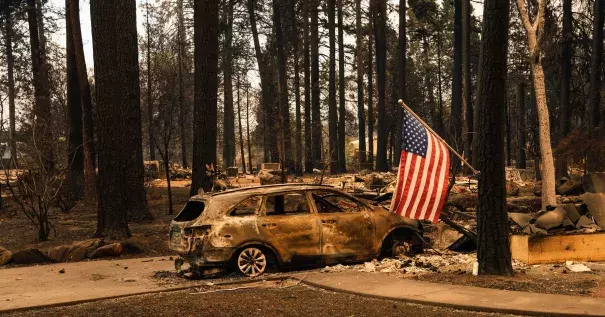Take a Good Look, America. This Is What the Reckoning Looks Like

For nearly a week, fires of unprecedented speed and ferocityhave been tearing through California. Up in the north, the Camp Fire is only 25 percent contained, yet it is already by far the deadliest and most destructive in state history—it’s killed 42 and destroyed nearly 7,200 structures. In the south, the Woolsey Fire has scorched over 90,000 acres and leveled at least 370 structures, many of them mansions in Malibu.
We can point to the wind or the lack of rainfall to explain the flames laying waste to Californian homes. But the devastation of this month’s fires is ultimately a product of a warming world. The climate change reckoning is here. This is what inaction looks like.
The tricky thing about climate change is that it’s hard to notice if you’re not looking in the right places. But here’s a list, to get you started: Inuit peoples in northern Canada have less of the ice they rely on to hunt, coral reefs are buckling under the weight of warming and acidifying waters, climate change is making hurricanes worse. These changes may be subtle to the human eye.
You probably did notice, though, that California is burning. The contribution of climate change to this evolving disaster isn’t speculative—it’s pretty obvious in the data. “Some folks will say, well, a few degrees of temperature increase, fires are burning at 1,000 degrees Fahrenheit, how can that possibly make a difference?” says UCLA climate scientist Daniel Swain. The warming manifests in what’s known as the vapor-pressure deficit. “So essentially how much water the atmosphere wants to suck out of the living vegetation.”
California is already very dry due to lack of rainfall. That means parched vegetation, which means lots of fuel for fires. But as temperatures climb, the atmosphere further dehydrates vegetation. At this time of year, a third factor comes into play: so-called downslope windstorms that pour in from the east. As they descend down the Sierra Nevada Mountains, they accelerate and heat up, further dehydrating the vegetation.
It’s all a matter of timing. Usually by this point in the year, California has at least a little bit of rain to rehydrate vegetation. But in these times of climate change, that’s becoming less reliable. “Interestingly, even though there haven't been large trends in the overall average precipitation in California, there has been a drying trend in autumn in particular,” says Swain.


